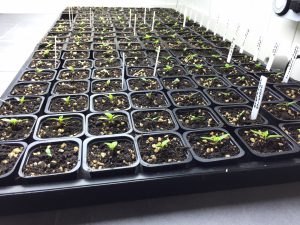Retraining Chili - Part 1
Posted by REMY EKORNSETER

Retraining the chili is an important part of the process. It has been repeatedly proven that a chilli plant gets bigger the bigger the pot it is in. Actually, this is a very simple step in the process, but very important and medium time consuming.

First retraining:
When the plants have got their real leaves in your medium it is time to move them over to proper soil and get a little more room to build up the roots. Normally I tend to plant them up to 3-4 times before they go out in the spring. It is natural to start with 6×6 pots in the first instance, although you can go bigger directly. But when you cultivate, you want to hold back growth so that the plants don't drag on and get too big before you have the opportunity to set them out. 
Normally, there is no need for nourishment yet. The soil you use (rose soil, plant soil, vegetable soil, e-soil, flower soil) already contains some nutrients, but you want minerals. Here I add basalt + about 2-4 tbsp. This does not burn the plant. However, you must be careful that the land you buy is not heavily fertilized. In my case, I use Hasselför's E-soil which is organic or Simontorp's organic rose soil. These have a good composition of the components and form an airy and good soil. It is a good idea to add Perlite to the soil. This is to get more pockets of air, make the soil lighter and increase drainage. I have 15-20% with Perlite. Mix the soil well and add a small handful of bat guano, a tablespoon of Epsom salt per 10 liters of soil.

When replanting them, it is advantageous to plant them a little deeper, especially if it has been warm and with little light so the plants have shrunk a little. If you use seed soil, you easily loosen the soil by squeezing around the pot, or poking it out of the cells if you have sown in cell trays. Try not to remove soil around the roots, except what is easily shaken off. Put soil in the pots you are going to retrain and carefully pack the plant down and fill up with soil. Water well and continue with the next one. If you have sown in rockwool or rootit cubes, you simply place the whole thing in the soil. The plants may droop a little when they are replanted, but usually recover within a few hours.




